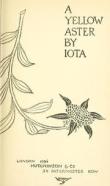AustLit
The material on this page is available to AustLit subscribers. If you are a subscriber or are from a subscribing organisation, please log in to gain full access. To explore options for subscribing to this unique teaching, research, and publishing resource for Australian culture and storytelling, please contact us or find out more.
Latest Issues
Notes
-
Written while author was resident in Australia.
Publication Details of Only Known VersionEarliest 2 Known Versions of
Works about this Work
-
Garment No. 5 : The New Woman Novel and the First Maternity Clothes
2014
single work
criticism
— Appears in: CEA Critic , November vol. 76 no. 3 2014; (p. 259-266) 'The tea gown (or, alternatively, tea-gown, tea dress, or robe d’interieur) first appeared in 1877 (Cunnington 283) and peaked in popularity in the 1890s and 1900s. The major difference between a tea gown and a regular dress was its loose fit and the fact that it did not require a corset: the bodice (the fitted portion of the gown which extends from shoulder to waist) itself might be lightly boned, and it might either have an empire waist (cinched in directly beneath the bust, thus fitting loosely over the stomach), a princess waist (having no waist seam at all, but long darts instead), or a loose belt. Because of this lack of undergarments, it was generally not worn in public or by unmarried women. According to Patricia A. Cunningham, the tea gown constituted “the upper end of th[e] class of comfortable ‘at home’ clothing” (7). The tea gown was either derived from artistic dress or from the peignoir, a sort of fancy dressing gown; there is some discussion on this topic among fashion historians.' (Introduction) -
Cosmos Magazine and Colonial Femininity
2012
single work
criticism
— Appears in: JASAL , vol. 12 no. 1 2012; 'This article looks at the relatively short and colourful life of Sydney's Cosmos: An Illustrated Australian Magazine—one of the many ephemeral literary magazines that flourished briefly during the colonial era in Australia, and which have been largely forgotten today. From its beginning in September 1894, Cosmos published poetry, short fiction, book reviews, and literary criticism, aiming to offer readers something 'that was purely Australian' as well as providing an important venue for the writings of popular colonial authors such as Louise Mack, Edward Dyson, Ernest Favenc, and many others. This article argues the Cosmos magazine was deeply invested in the development of a distinctively Australian literary culture and that an important focus for accomplishing this was its exploration of metropolitan modes of colonial femininity.' -
'A Yellow Aster' : The Author at Home
1894
single work
column
— Appears in: The Woman's Signal , 8 March no. 10 1894; (p. 52-3)
-
'A Yellow Aster' : The Author at Home
1894
single work
column
— Appears in: The Woman's Signal , 8 March no. 10 1894; (p. 52-3) -
Cosmos Magazine and Colonial Femininity
2012
single work
criticism
— Appears in: JASAL , vol. 12 no. 1 2012; 'This article looks at the relatively short and colourful life of Sydney's Cosmos: An Illustrated Australian Magazine—one of the many ephemeral literary magazines that flourished briefly during the colonial era in Australia, and which have been largely forgotten today. From its beginning in September 1894, Cosmos published poetry, short fiction, book reviews, and literary criticism, aiming to offer readers something 'that was purely Australian' as well as providing an important venue for the writings of popular colonial authors such as Louise Mack, Edward Dyson, Ernest Favenc, and many others. This article argues the Cosmos magazine was deeply invested in the development of a distinctively Australian literary culture and that an important focus for accomplishing this was its exploration of metropolitan modes of colonial femininity.' -
Garment No. 5 : The New Woman Novel and the First Maternity Clothes
2014
single work
criticism
— Appears in: CEA Critic , November vol. 76 no. 3 2014; (p. 259-266) 'The tea gown (or, alternatively, tea-gown, tea dress, or robe d’interieur) first appeared in 1877 (Cunnington 283) and peaked in popularity in the 1890s and 1900s. The major difference between a tea gown and a regular dress was its loose fit and the fact that it did not require a corset: the bodice (the fitted portion of the gown which extends from shoulder to waist) itself might be lightly boned, and it might either have an empire waist (cinched in directly beneath the bust, thus fitting loosely over the stomach), a princess waist (having no waist seam at all, but long darts instead), or a loose belt. Because of this lack of undergarments, it was generally not worn in public or by unmarried women. According to Patricia A. Cunningham, the tea gown constituted “the upper end of th[e] class of comfortable ‘at home’ clothing” (7). The tea gown was either derived from artistic dress or from the peignoir, a sort of fancy dressing gown; there is some discussion on this topic among fashion historians.' (Introduction)
Last amended 2 May 2017 12:51:15




